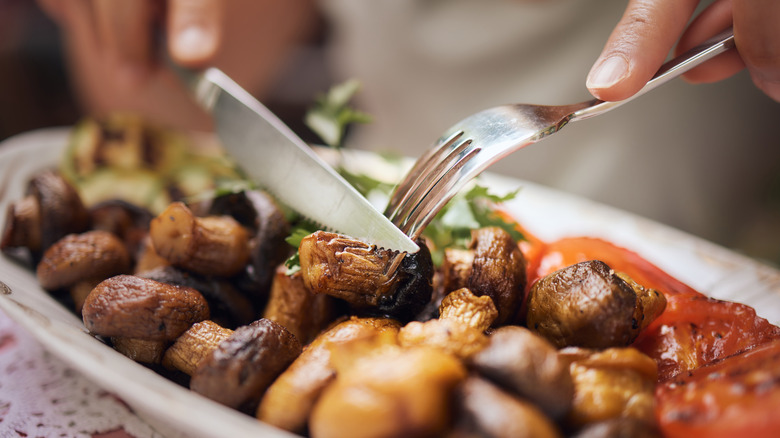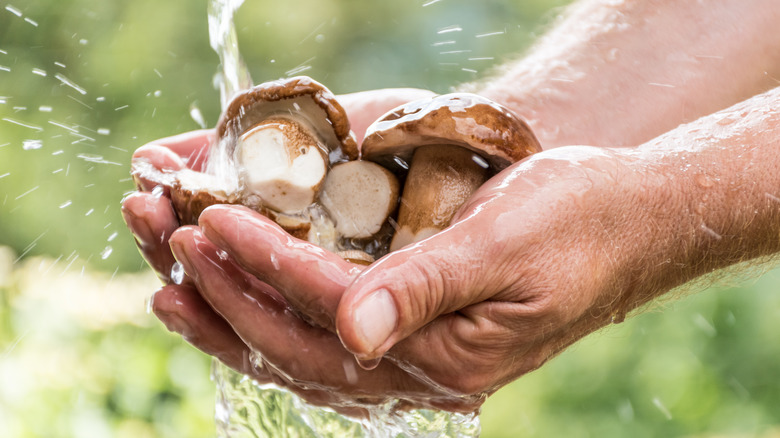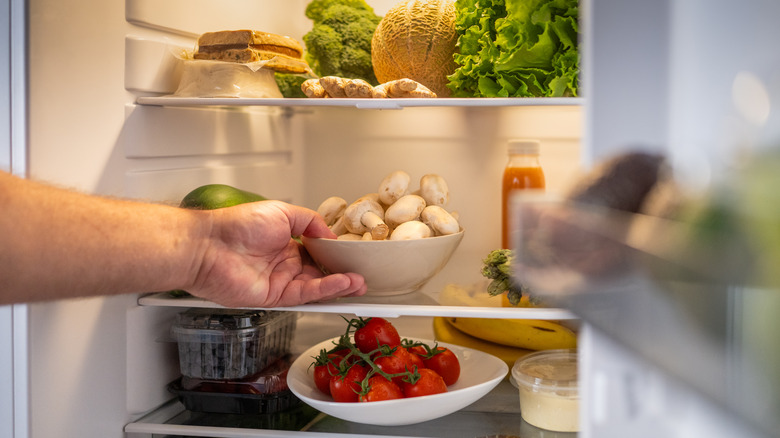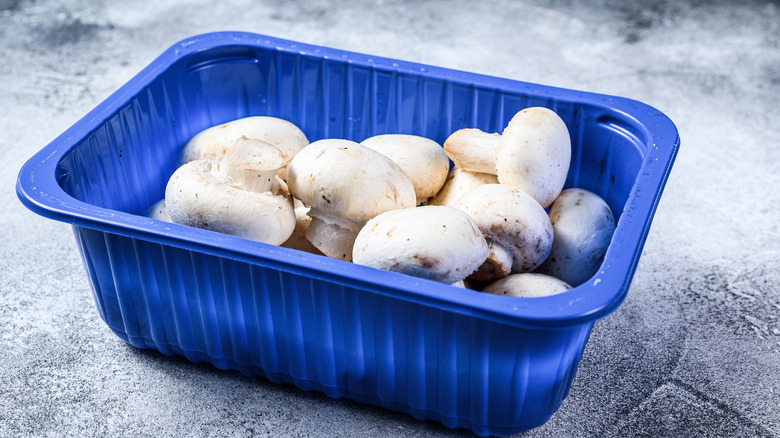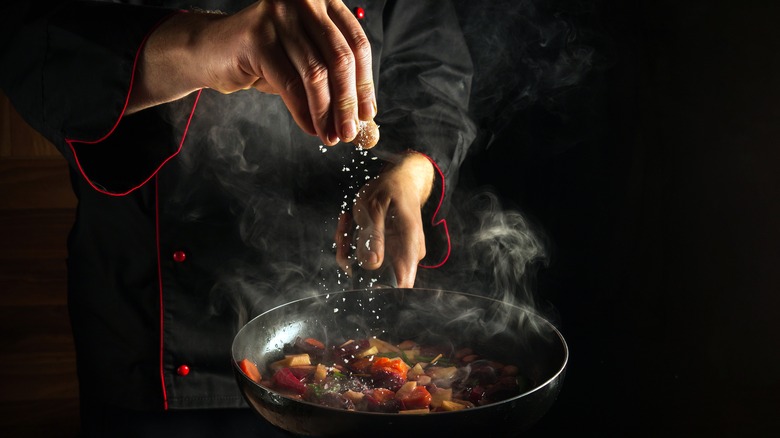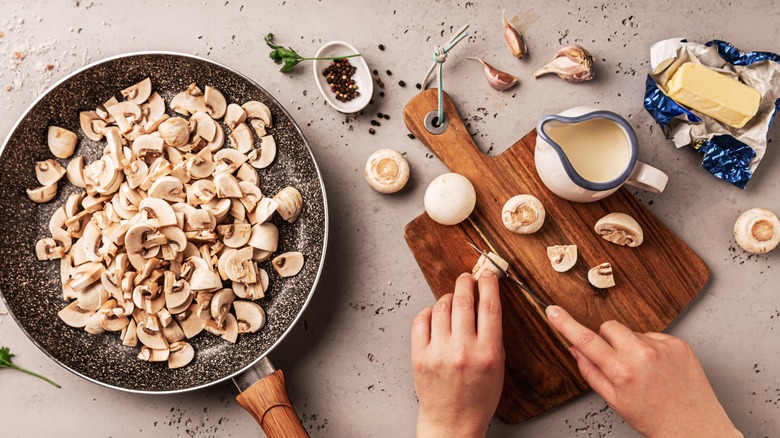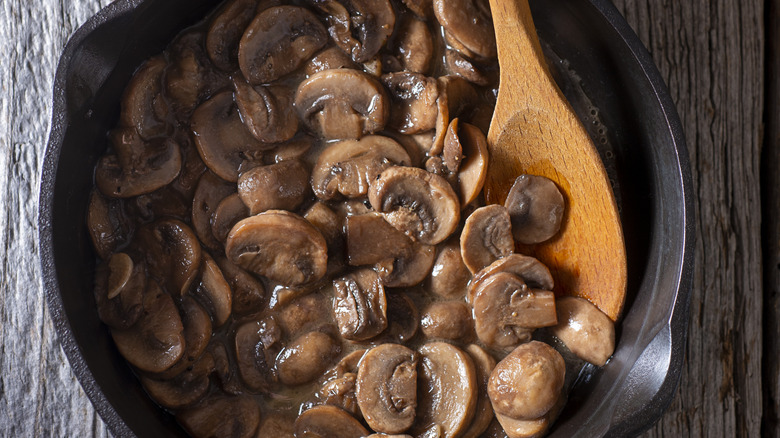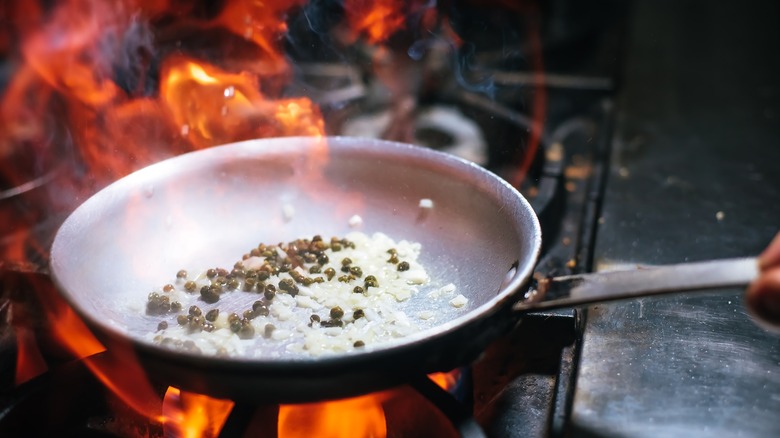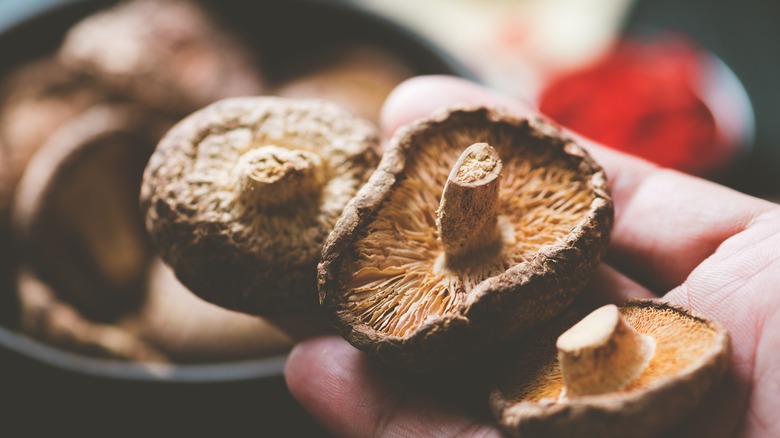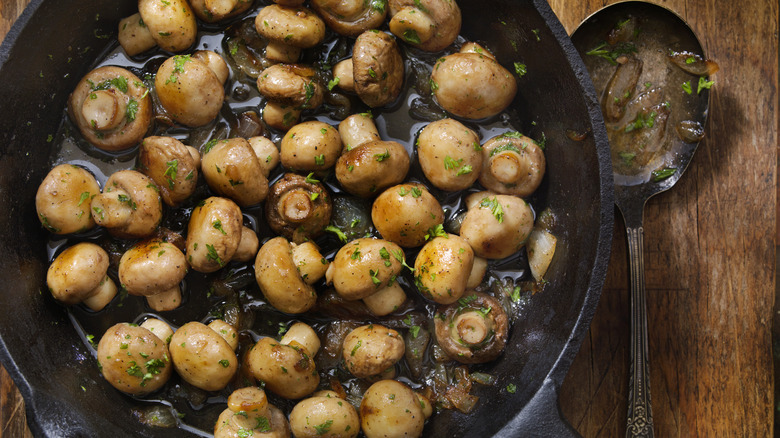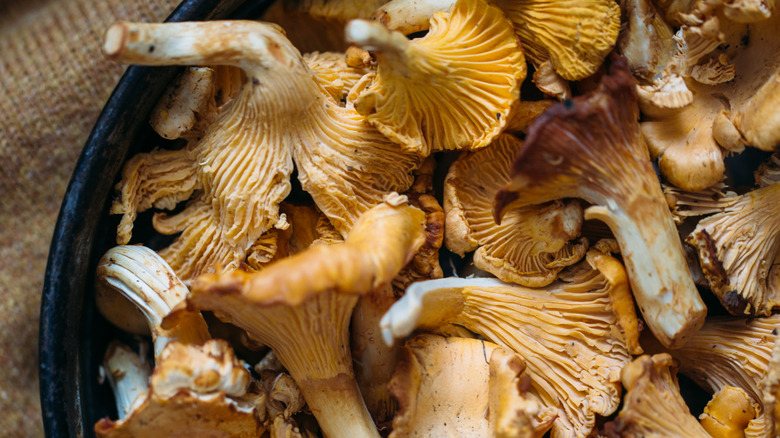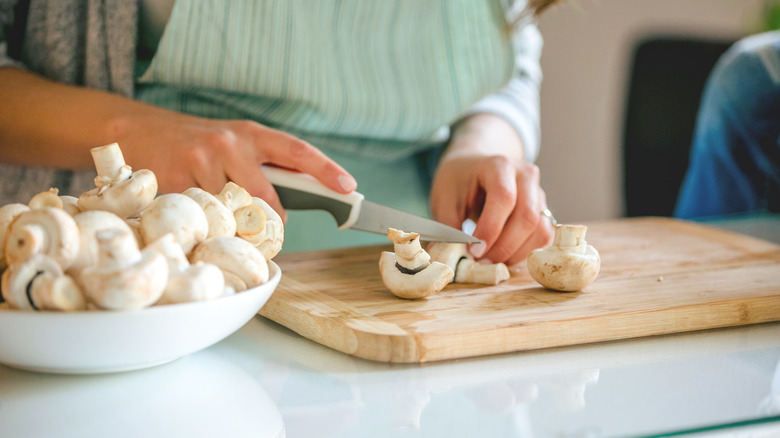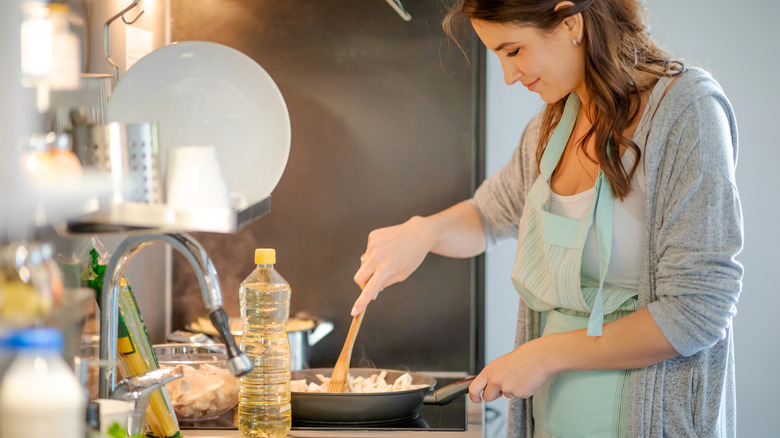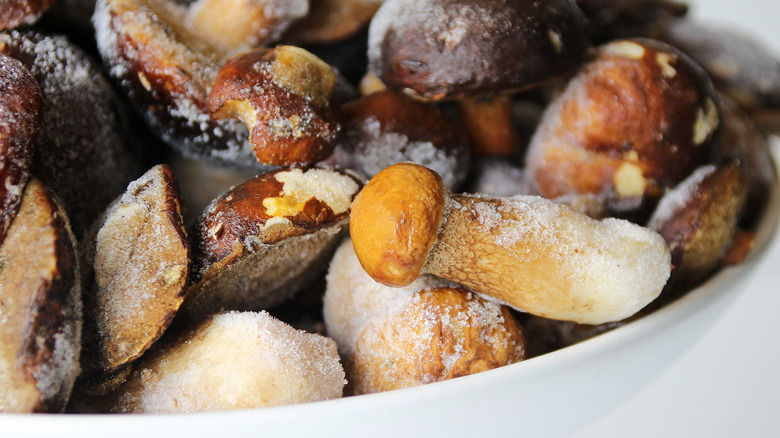Common Mushroom Mistakes Everyone Needs To Stop Making
Shiitakes, oyster, button, portobello — the textures, tastes, and types of mushrooms are truly endless. From enjoying them raw in salads to sauteing them in white wine and garlic to roasting and grilling and enjoying them as a meat substitute, mushrooms are a nutritious and delicious part of any savory meal. But working with them is something that takes a bit of know-how and finesse to get the most out of your fungi.
For example, most folks know that washing your mushrooms under running water upon getting them is a huge no-no. The fungus acts as a sponge, and your resulting dish could end up water-logged and lacking in flavor. Other rudimentary mistakes include incorrectly storing them, adding too much or not enough salt (and at the wrong time), overcrowding your roasting or sautéing pan, or even skimping on your fat of choice — be it bacon grease or olive oil. Here are some of the most common mistakes people make when cooking mushrooms and how to avoid them when whipping up fungi of your own.
Overwashing your mushrooms
One of the cardinal mistakes when it comes to mushrooms is over-washing them. This could come as a surprise to some since freshly foraged mushrooms — including those snatched up at the farmers market — are often pretty dirty and dusty. Your first instinct may be to put them in a strainer and wash them until they're immaculate, but the result would be spongy, soft, and water-logged fungi more likely to steam than sauté.
Instead of running those shiitakes or button mushrooms under the faucet, wet a paper towel or washcloth and gently wipe each mushroom, being careful not to transfer too much water to each. This should easily remove dirt or debris from the caps and stems, making them fresh and good enough for processing and eating. You can also invest in a mushroom cleaning brush. These brushes act like little dusters for fungi, allowing you to clean them without damaging the mushroom. Regardless of how you clean them, try not to be too nit-picky with a little dirt here and there.
Incorrectly storing them
Mushrooms tend to be a little finicky when it comes to storage, but understanding what variety you have and what it needs can prevent a costly mistake resulting in moldy mushrooms or trashed fungi. As a general rule, mushrooms can and should be stored in the refrigerator in a paper bag lined with paper towels as soon as you bring them home. You can also use a produce basket like the kind you'd get strawberries in; so long as it's open and breathable.
They can be stored on a countertop for about a day — helpful if you're using them right away — but as a rule, it's best to get them into the cold as soon as you can. It's a good idea to store mushrooms as close to freezing as possible without actually freezing, as a stint in the freezer could harm their quality and nutrient density. Do not put your mushrooms in the crisper drawer of your refrigerator, either. There, they'll suffer a fate of too much moisture and eventual slime.
Buying prepackaged mushrooms
Speaking of incorrect storage, those mushrooms you've seen lining the shelves of your local grocer's produce aisle — wrapped in plastic and smashed into plastic or styrofoam containers — are not the best choice when it comes to choosing good fungi. As a rule, mushrooms stored this way are usually more expensive and more than you'll need for your recipe. Additionally, as usually happens with vegetables packed this way, you can't see the mushrooms underneath that top layer. Are they fresh? Slimy? Dirty? Moldy? A lot of "yuck" could be hidden from the naked eye in this kind of packaging.
Instead of setting yourself up for potential disappointment, head to your local farmers market and buy exactly what you need. Many grocers also offer this option, allowing you to place the mushrooms you need directly into a paper bag, setting them up for freshness and longevity in your fridge ahead of their exciting culinary future.
Adding salt too soon
Mushrooms bring their own brand of umami and earthy savoriness to any dish. Think of a simple roasted piece of salmon or a cut of steak — even a humble (and cheap) whole chicken. The salmon can be elevated into a simple but delicious sheet pan meal with mushrooms and baby bok choy. The steak goes next level with a red wine and sauteed mushrooms, complemented with a compound butter. The chicken is spatchcocked with shiitakes, hedgehog mushrooms, and kale for an impressive meal that feeds more than a few hungry mouths.
But each of these recipes depends on the chef knowing when and how to season the mushrooms; not doing it at the right time can make or break your dish, no matter how simple. The trick to salt and mushrooms is to season them after they've done the majority of their cooking. Adding salt at the beginning of the mushrooms' cooking will result in them browning slower, releasing more water (therefore steaming rather than sauteeing), and becoming rubbery instead of soft. Instead, wait until your mushrooms are nearly done cooking and at the soft, succulent consistency you want. Then, you can add your salt.
Introducing oil or fat at the wrong time
For those who are frequent cooks, it's a good rule of thumb to get your oil or fat of choice heated in your pan pre-sauté. Whether you're using bacon grease, good quality olive oil, vegetable oil, or even coconut oil, most of us have it ingrained in us to heat our oil before adding aromatics or whatever our recipe calls for. Mushrooms sort of break this rule. After prepping your mushrooms, if you did add them to a pan with a few tablespoons of hot oil or fat, they'd simply absorb it and end up steaming, not browning. You'd likely be left with spongey, border-line mushy mushrooms full of oil — not the crispy, soft yet chewy consistency you were looking for.
The trick to adding your oil or fat of choice to impart a nice, unctuous flavor for your shiitakes, button, portobello, or morel mushrooms, is actually to add it later in the cooking process. According to Fantastic Fungi, start your mushrooms in a hot, dry pan and cook them until they've achieved the level of done-ness you're looking for, usually a bit of a golden brown sear and lack of moisture. Add a little bit of your oil or fat of choice after they seem to be done sizzling, then finish them off. Remember, adding too much will make them greasy!
Crowding the pan
Like most of us, vegetables and mushrooms need a little space — room to breathe, if you will. Whether you're roasting or sautéing, you never want to pile any vegetables up high. Because they're so water-heavy, mushrooms and vegetables like zucchini, onions, and peppers all release their liquid as soon as they come into contact with heat. When they're properly spread out in a pan or on a sheet pan in the oven, space allows them to release that water and get toasty, golden brown. When you pile them and overcrowd any pan, they steam. The water that's leaching out has nowhere to go but into the mushroom or vegetable next to it. So, instead of a nice crisp sear or a golden brown bite, you'll get a result like those bagged veggies you throw in the microwave. Maybe it's not the worst, but it certainly isn't what you were likely going for.
Instead, you'll want to spread out your mushrooms as much as possible in your hot pan. Aim for them not to touch each other (though a bit of overlap here and there is fine). That should leave you with plenty of room for your mushrooms to get crispy AND room for you to easily flip and stir the fungi as they cook.
Cooking over too low heat
As you may or may not have picked up from the other helpful tips we've offered, mushrooms — to realize their full culinary potential — need a hot, dry pan. Because mushrooms are by nature very water-heavy, a hot pan, grill, or roasting pan helps them to quickly release their excess moisture, resulting in the browned, crisp, and chewy texture we've come to know and love. But if your heat ends up being too low, the mushrooms can become damp, soggy, and spongey. By the same rule, if you heat the mushrooms too high, they can burn and become singed.
Your best option is to heat your pan (sans oil) over medium to medium-high heat before adding your mushrooms. Then, cook them until they've stopped sizzling, which means they've released the majority of their water. If you're grilling, look for crispy, grill-marked mushrooms that aren't spongey or mushy.
Choosing boring varieties or choosing the wrong mushrooms for your dish
If you aren't an avid mushroom connoisseur or frequently cook fungi, you may be a little lost as to the many different types available for cooking. For the uninitiated, a trip to the produce section may not give up many more varieties than white button mushrooms or portobellos. While both of those can be delicious in their own right, they're pretty tame in terms of flavor. Button mushrooms are usually what you'll find on your average takeout pizza, and portobellos are frequently grilled and added to burgers.
To branch out a bit, cremini and shiitake mushrooms are a good place to start for someone not super familiar with cooking techniques or flavors of different mushroom varieties. You could also take a trip to your local Asian market and try dried varieties or fresh enoki mushrooms, which are mild and add a fun burst of texture to any dish. You can also get involved with local foraging groups and try whatever grows in your neck of the woods — just be sure to go with the help and guidance of an expert.
Rushing the cooking process
As with most delicious dishes, cooking mushrooms takes time and patience. You wouldn't try to cook a roast chicken dinner in under 20 minutes, rush through the finesse demanded of a finicky homemade pasta in less than an hour, or roast a pan of assorted vegetables in 3 minutes. So go the rules of mushrooms — regardless of variety.
First, as stated earlier, ensure your pan is at the right temperature before adding your mushrooms. Once you've got them in the pan, take your time so that the mushrooms develop a nice, golden brown color, which could take anywhere from 5 to 10 minutes. As a rule, you can't overcook mushrooms — they'll just continue to release water until nothing is left (whether you're roasting, grilling, or sautéing). Additionally, cooking mushrooms slowly over medium to high heat in a dry pan will help to concentrate the fungi's sugars and acids — resulting in a much more flavorful bite than you'd have with a rushed dish.
Tossing the stems
One of the first things that many home chefs do upon bringing home their foraged or bought bags of mushrooms is to clean them and remove the stems. If you're using your mushrooms for a raw application, like a salad, then it's probably okay to remove the stems as they could be woody and tough. However, throwing them out would be a disservice, according to The Guardian.
Mushrooms usually aren't the cheapest of the items found in the produce section, so stretching them as far as possible — and making use of the stems — makes sense from a financial standpoint. Furthermore, the stems contain the same amount of flavor and nutrients as the caps and can be finely diced for mushroom stem duxelles, which makes use of your entire mushroom haul. If you've got tougher mushroom stems — like those found on shiitakes — they can still be cooked the same as the caps and utilized in blended or pureed soups and stews, like an umami-rich cream of mushroom soup perfect for a chilly day.
Cutting your mushrooms incorrectly
As with most ingredients, properly prepping and cutting your mushrooms makes a world of difference in your culinary execution. Mushrooms that are too big, make use of mixed stems and caps in the wrong applications, aren't properly cleaned, are diced too small, or even sliced too thin can all lead to less-than-amazing results in your mushroom-laden dishes.
Take, for example, slicing your mushrooms too thin: mushrooms shrink as they cook since they're releasing tons of water. If you're sautéing a bunch of mushrooms and have sliced them paper thin, you'll end up with overly crispy, chewy, and possibly burnt fungi. If you're utilizing button, cremini, or portobello mushrooms, slicing them on the thicker side or even quartering them could result in a much better end dish; depending on what kind of texture and eating experience you're looking for. Small mushrooms — like morels or enoki — can be cooked whole, while others can be torn into similarly-sized pieces.
Over-stirring mushrooms as they cook
In the same theme as not rushing your mushrooms, you should also live by the rule of not messing with or over-stirring your mushrooms. If you've ever made rice, you know that lifting the lid of your pot, stirring, or otherwise messing with the grains will cause steam to escape, leaving you with likely crunchy, oddly textured rice instead of fluffy, soft, pillowy grains. Mushrooms — whilst they're sautéing — should be treated in much the same way.
Once you've added your diced or cut-up mushrooms to your dry, hot pan, stir them around once or twice — then leave them be! Too much stirring can cause the water being released by your mushrooms to be re-absorbed and stuck under the caps and pieces, resulting in steamed 'shrooms and soggy bites instead of the crisp, golden-brown goodness you're looking for. As they get closer to this golden stage, you can stir again, but in the interim, it's best to leave them alone. Remember that mushrooms are next to impossible to overcook, so you aren't in any real danger of wrecking your dish.
Using frozen mushrooms
Before getting up in arms about the financial benefits of using packaged frozen mushrooms, hear us out. Frozen varieties of mushrooms found pre-bagged and ready to steam or cook in the freezer section of your store are fine for your cooking needs. However, buying an abundance of fresh mushrooms and then tossing them in the freezer yourself is not going to yield anything other than rubbery, mushy, and water-logged fungi. The reason is because of the high water content in your fresh mushrooms. Once they're frozen and consequently thawed, they're going to behave like sponges, and a lot of the nutrients, too, will more or less disappear.
If you do find yourself with an overabundance of fresh mushrooms and freezing feels like the only answer to not waste them, there is a way to somewhat salvage them. Par-cook your fresh mushrooms by steam-blanching or sautéing them before you freeze them. Mushrooms can be steam-blanched in a mixture of lemon juice and water then tossed in a bowl of ice water and drained before being dried and placed in the freezer. Sautéing can be done as you would normally before serving your mushrooms, and this way you're one step ahead of whatever side dish or recipe you'd be using in the future.
